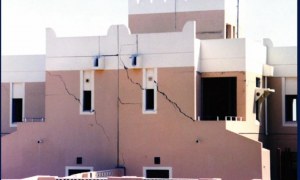🕑 Reading time: 1 minute
Cantilever retaining wall are usually of reinforced concrete and work on the principles of leverage. It has much thinner stem and utilize the weight of the backfill soil to provide most of the resistance to sliding and overturning. Cantilever retaining wall is the most common type of earth-retaining structure. It is constructed of reinforced Portland-cement concrete (PCC) was the predominant type of rigid retaining wall used from about the 1920s to 1970s. Earth slopes and earth retaining structures are used to maintain two different ground surface elevations. Function of Cantilever Retaining Wall
To retain the soil at a slope that is greater than it would naturally assume, usually at a vertical or near vertical position.
Design Consideration
In order to calculate the pressure exerted at any point on the wall, the following must be considered:
Function of Cantilever Retaining Wall
To retain the soil at a slope that is greater than it would naturally assume, usually at a vertical or near vertical position.
Design Consideration
In order to calculate the pressure exerted at any point on the wall, the following must be considered:
- Height of water table
- Nature & type of soil
- Subsoil water movements
- Type of wall
- Material used in the construction of wall
- Active earth pressure - It is the pressure that at all times are tending to move or overturn the retaining wall
- Passive earth pressure - It is reactionary pressures that will react in the form of a resistance to movement of the wall.

Figure 1 :Typical reinforced concrete cantilever walls
2 ) If form 1 is not practicable, a cantilever wall with a large toe must be used.
Figure 2 : Typical reinforced concrete cantilever retaining walls
From figure 1 and 2:- The drawing show typical section and pattern of reinforcement encountered with these basic forms of cantilever retaining walls.
- The main steel occurs on the tension face of the wall and nominal steel (0.15% of the cross-sectional area of the wall) is very often included in the opposite face to control the shrinkage which occurs in in-situ concrete work.
- Reinforcement requirements, bending, fabricating and placing are dealt with in the section on reinforced concrete.
 Advantages and details about cantilever wall
Reinforced cantilever walls have an economic height range of 1.200 to 6.000 m; walls in excess of this height have been economically constructed using prestressing techniques. Any durable facing material may be applied to the surface to improve the appearance of the wall but it must be remembered that such finishes are decorative and add nothing to the structural strength of the wall.
Cantilever Wall Failure
Advantages and details about cantilever wall
Reinforced cantilever walls have an economic height range of 1.200 to 6.000 m; walls in excess of this height have been economically constructed using prestressing techniques. Any durable facing material may be applied to the surface to improve the appearance of the wall but it must be remembered that such finishes are decorative and add nothing to the structural strength of the wall.
Cantilever Wall Failure
- Effect of water: Ground water behind a retaining wall, whether static or percolating through a subsoil, can have adverse effects upon the design and stability.
- Slip circle failure: sometimes encountered with cantilever wall in clay soils particularly if there is a heavy surcharge.
- Low quality of material that use in cantilever construction
- Low design reinforcement in cantilever wall.
- Mistake in calculate height of water table, nature & type of soil.
- Subsoil water movements.
- Cantilever wall be in sloping position.
- Cantilever wall had curve on its surface/wall.
- Crack on wall structure.
- Cantilever wall awashed.


